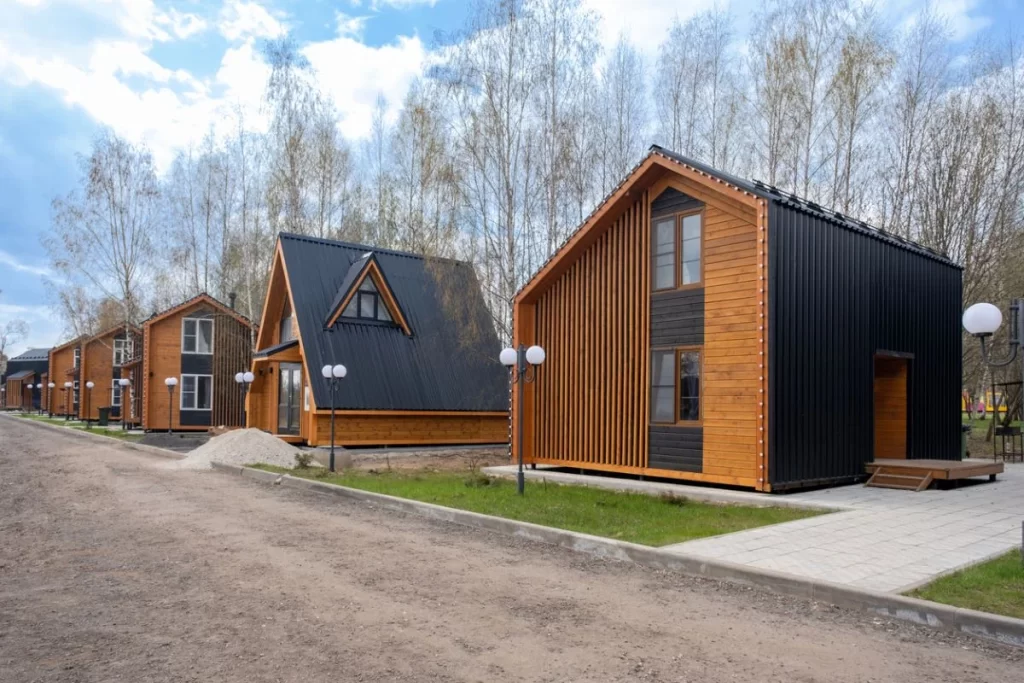Over the last decade, the rise of tiny home communities has not only captured the imagination of those yearning for a simpler way of life, but has also presented itself as a beacon of hope for pressing societal challenges such as global warming & affordable housing.
In California, the innovative use of tiny homes as a solution to the homelessness crisis underscores the versatility and potential of these compact living spaces. Tiny home communities are being built all over the world that are having large impacts on how we traditionally view housing.
This evolution from niche lifestyle choice to a societal solution hints at the broader implications of tiny home living for addressing affordability, sustainability, and community living challenges.
The Appeal of Tiny Home Communities
Tiny house communities are more than just collections of homes; they are the embodiment of a radical rethinking of what it means to live well.
These communities are meticulously planned to balance private living with communal engagement, thereby offering a sustainable model of living that is in stark contrast to the isolating suburban sprawls of the 20th century.
The appeal lies in their ability to merge the autonomy of owning a home with the benefits of communal resources, like shared gardens, workshops, and communal dining areas, fostering a sense of unity and shared purpose among residents.
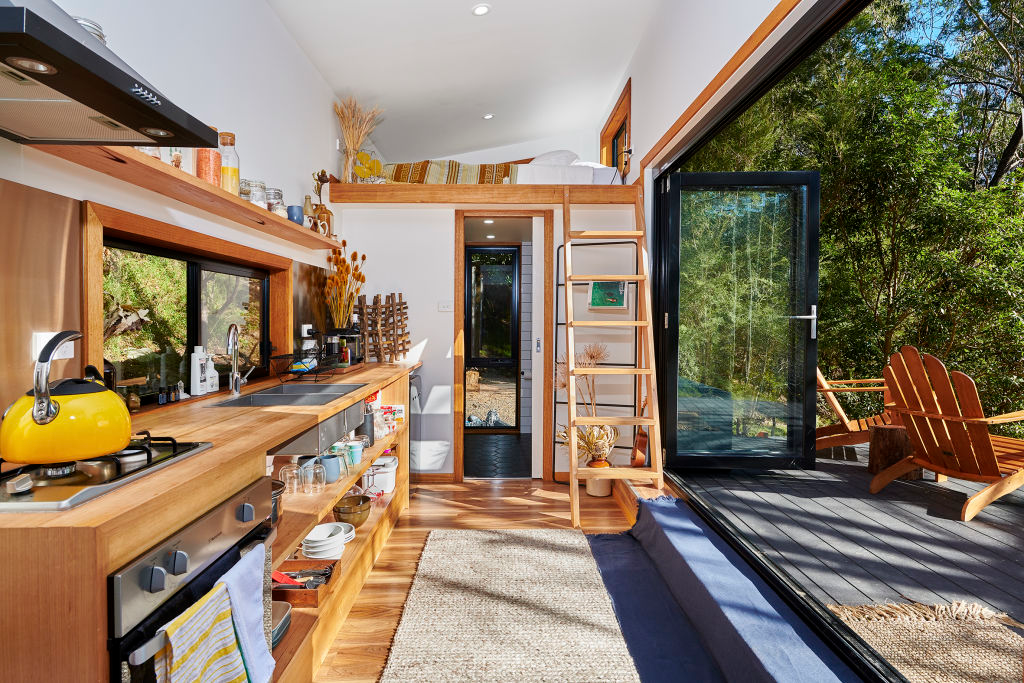
Financial Freedom with Tiny Home Living
The economic advantages of tiny house living are compelling. The lower cost of tiny homes, coupled with the shared expenses of community living, makes it an attractive option for people from all walks of life.
From young professionals looking to avoid the trap of mortgage debt to retirees seeking to downsize in their golden years, tiny house communities offer financial freedom that is often unattainable in traditional housing markets.
On average, a tiny home can cost between $10,000 and $50,000, a fraction of the median price of a traditional house in the U.S., which hovers around $300,000. This drastic difference in initial investment opens the door to homeownership for a broader segment of the population. You can get started building your own tiny home for as low as $15,000.
The savings don’t stop at the purchase price. Tiny homes incur lower utility bills, reduced maintenance costs, and oftentimes, minimal property taxes. Their small size leads to an efficient use of energy, slashing monthly expenses and leaving more room in budgets for other financial goals or leisure activities.

Lower Upfront Costs
Embracing tiny house living inherently means a smaller financial outlay for your home. The reduced square footage directly translates into a lower purchase price, easing the barrier to homeownership.
In the realm of traditional housing, a smaller price tag is often synonymous with compromise. Tiny house communities, however, offer an alignment of affordability and quality living conditions without the typical financial strain.
Tiny houses present a reduction in resource consumption, echoing a cost-effective lifestyle.
The financial allure of tiny living extends beyond just the acquisition. With a tiny home, you stand to benefit from minimal utilities, lower taxes, and reduced maintenance costs. Thus, the cumulative savings begin the moment you step through your new, perfectly proportioned door.
Reduced Monthly Expenses
Monthly costs are sizably diminished in a tiny house.
Having a smaller living space translates to decreased utility bills. The compact size of a tiny home necessitates fewer resources—be it electricity, water, or gas—resulting in lower monthly charges. Additionally, tiny homes are often designed with energy efficiency in mind, which furthers the reduction of ongoing expenditures.
Insurance premiums typically fall with less square footage.
Property taxes are generally lower for tiny houses. Due to their reduced dimensions and often mobile nature, these dwellings can offer significant savings on annual property tax obligations compared to their conventional counterparts.
Investing in a tiny house community can significantly bolster one’s financial stability. With the median price of homes in the United States soaring in recent years, a tiny living option offers a palpably more affordable inroad to homeownership.
This sustainable approach provides individuals with reduced monthly outlays, allowing for a reallocation of funds towards investments, retirement, or other financial aspirations.
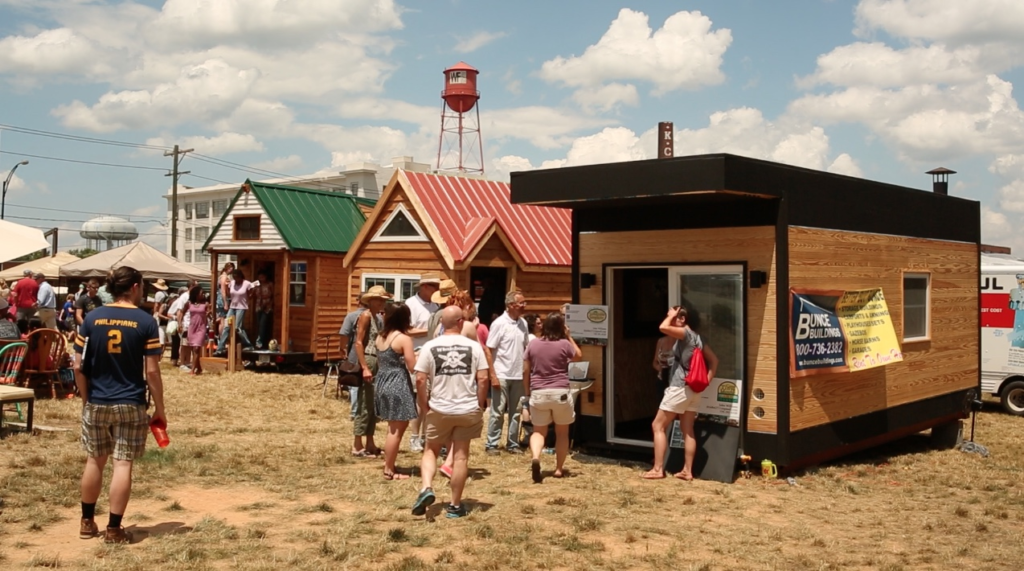
Minimalist Lifestyle Savings
Embracing a minimalist lifestyle within a tiny house community carries financial benefits that extend beyond mere initial cost considerations. Less space equates to fewer possessions, which in turn can translate into substantial savings over time.
The reduction in personal clutter eliminates the need for additional storage spaces or larger living areas.
Inhabitants of tiny homes find that their need for consumer goods diminishes as they align their lifestyles with space constraints, fostering an environment that prioritizes quality over quantity. As a result, they often experience a decrease in compulsive purchasing, leading to long-term financial freedom.
Committing to a smaller living area cultivates a mindset of conscious consumption, with residents that intuitively resist the lure of unnecessary acquisitions. This spartan approach minimizes instances of superfluous spending, enabling individuals to channel capital into meaningful experiences, personal growth, or the accumulation of wealth. As such, the “tiny” in tiny living translates to a significant downsize in needless expenditures.
Enhanced Community Interaction
In the close-knitted fabric of a tiny home community, the proximity to neighbors naturally fosters greater social engagement. Reduced physical barriers prompt an increase in spontaneous conversations, shared meals, and communal activities. Such consistent interaction nurtures a sense of belonging, which is integral to human happiness and well-being.
The architecture of tiny home communities often includes common areas designed to encourage socialization, akin to the conceptual framework of a village green. This very layout is conducive to the cultivation of strong, supportive networks. Residents frequently find that their connections within the tiny home community deepen over time, not only providing camaraderie but also a safety net in times of need.

Shared Spaces Foster Connection
In tiny home communities, shared spaces act as a catalyst for unity and interpersonal growth.
- Community Gardens: A verdant space for collaboration and relaxation.
- Communal Kitchens: Where culinary skills are shared and new recipes discovered.
- Workshop Areas: A hub for creativity where residents can engage in a variety of crafts and projects.
- Outdoor Gathering Spaces: Ideal for yoga sessions, movie nights, or simply conversing under the stars.
- Laundry Facilities: An essential amenity that often becomes an unexpected place to socialize.
Through these communal areas, residents cultivate a sense of collective responsibility and stewardship.
These common locales are not just amenities, they’re the heartbeats of community life, facilitating serendipitous and profound human connections.
Shared experiences in these areas contribute to a resilient community fabric, making them much more than mere conveniences—they’re integral to the shared identity of the community.
Group Activities and Events
Engagement in group activities fosters a vibrant community spirit and encourages social interaction.
- Seasonal Festivals: Celebrating the changing seasons with festivals and traditions.
- Mindfulness Retreats: Communal activities focused on wellness and mental health.
- Creative Workshops: Opportunities for residents to explore their artistic side together.
- Communal Meal Preparations: Occasions for cooking and sharing meals as a collective.
- Educational Seminars: Learning experiences ranging from sustainability to personal development.
- Recreational Sports Leagues: Organized activities that promote fitness and teamwork.
- Movie and Game Nights: Enjoying entertainment and leisure in a group setting.
These shared experiences are at the core of a cohesive community.
Deep connections are nurtured through frequent collaborative and celebratory events.
Joint Resource Use
In a tiny home community, resources are pooled to maximize efficiency. This communal approach to resource allocation reduces individual expenses and fosters a culture of shared responsibility.
Shared utilities often lead to lower per-capita costs. Utilities like water, electricity, and Wi-Fi benefit from group rates.
Collective purchasing power can lead to significant savings. Bulk buying of supplies reduces overall cost and waste.
Certain amenities are communal rather than duplicated in every home. Tools, exercise equipment, and laundry facilities are typically shared resources among residents.
Embracing the ethos of “use only what you need” reflects a commitment to minimalism and conservation. This philosophy is demonstrated through joint investments in solar power or community gardens, which serve to both reduce environmental impact and enhance self-sufficiency.
Finally, sharing resources allows residents to access a diverse range of items. From specialized kitchen appliances to recreational gear, collective ownership enriches the living experience without the burden of individual possession.
Environmental Benefits
Tiny home communities inherently encourage a reduction in individual carbon footprints. The compact nature of these homes results in less energy consumption for heating and cooling purposes.
Moreover, there is typically a communal approach to managing waste and resources that further minimizes environmental impact. Practices such as composting, recycling, and careful water use are common, aligning with a sustainable lifestyle that mitigates ecological degradation.
Such communities also frequently incorporate green spaces, which not only improve air quality but also foster biodiversity and resilience against urban heat islands.
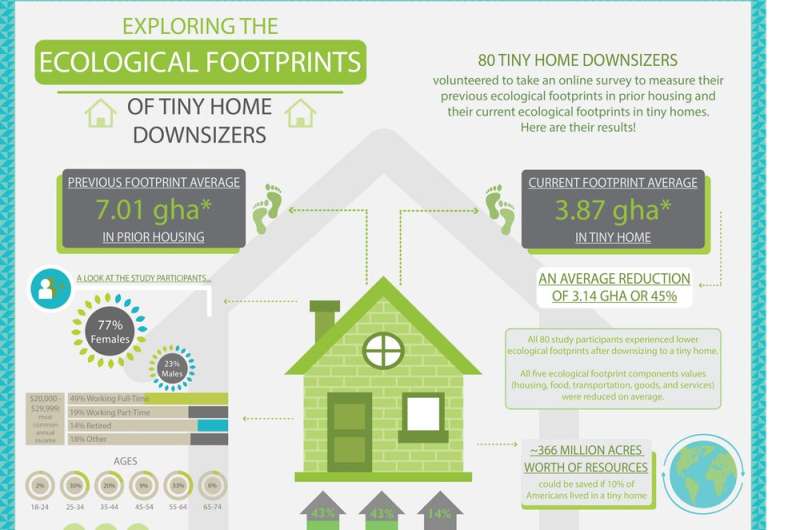
Sustainable Living Practices
Embarking on a community lifestyle inherently embraces a panoply of sustainable practices that are beneficial to both the environment and individual well-being.
- Minimized resource consumption: Residents typically use less water, electricity, and heating due to smaller living spaces.
- Renewable energy integration: Many communities invest in solar panels or other renewable energy sources to power communal and private spaces.
- Waste reduction strategies: Initiatives like composting and recycling are standard, decreasing the overall waste sent to landfills.
- Sustainable transportation options: Proximity to shared amenities often reduces the dependence on personal vehicles, encouraging walking, biking, or using electric scooters.
- Local food production: Community gardens contribute to food sustainability and provide access to fresh, organic produce.
- Eco-friendly building materials: Tiny houses are often constructed with sustainable materials, reducing the ecological impact of building processes.
These practices, collectively, forge a foundation for environmentally conscious living that carries profound implications for ecological conservation.
The collective spirit of a tiny house community engenders a culture of shared responsibility towards preserving our planet’s resources.
Holistic sustainability within these communities does more than merely tread lightly on the earth; it promotes a symbiotic relationship with the environment that underlines the inextricable connection between human activity and the natural world.
Smaller Carbon Footprint
Embracing the tiny home movement can significantly reduce one’s ecological impact, thanks to the decreased consumption of resources.
- Reduced energy needs: Smaller spaces require less energy for heating, cooling, and daily operations.
- Diminished waste: Compacter living conditions encourage more mindful consumption and waste reduction.
- Enhanced energy efficiency: Tiny homes can more effectively incorporate renewable energy sources like solar panels.
- Limited material usage: Constructing a smaller space necessitates fewer building materials, thus diminishing the environmental burden.
This lifestyle fosters an innate awareness of resource utilization, encouraging a frugal yet fulfilling way of life.
By opting into tiny home living, individuals undertake a profound commitment to environmental stewardship, affirming their dedication to a healthier planet.
Eco-Friendly Community Projects
Tiny Communities often embrace sustainability as a foundational ethos. Engaging in community gardens, members create symbiotic relationships with the land, fostering biodiversity. Rainwater harvesting systems adopted by these communities showcase commitment to conscientious water usage. Tiny home residents may collaborate on shared renewable energy projects, such as community solar arrays or wind turbines. Through these ventures, inhabitants demonstrate a holistic approach to sustainable living.
The Future is Tiny
Looking ahead, the tiny house movement is poised for exponential growth. As environmental concerns become more pressing, the housing crisis continues, and the desire for a more community-oriented way of life grows, tiny house communities represent a viable blueprint for the future of housing.
Innovations in design and policy adjustments are making it easier to adopt this lifestyle, with cities around the world beginning to recognize and accommodate the unique needs of tiny home communities. These compact dwellings not only promise a smaller ecological footprint but also a more connected and fulfilling way of life.
As we look towards the future, tiny homes stand out as beacons of hope, offering a path to a more sustainable, affordable, and community-oriented world. The shift towards tiny is not just a trend; it’s a paradigm shift in how we think about space, resources, and our relationships with each other and the planet.
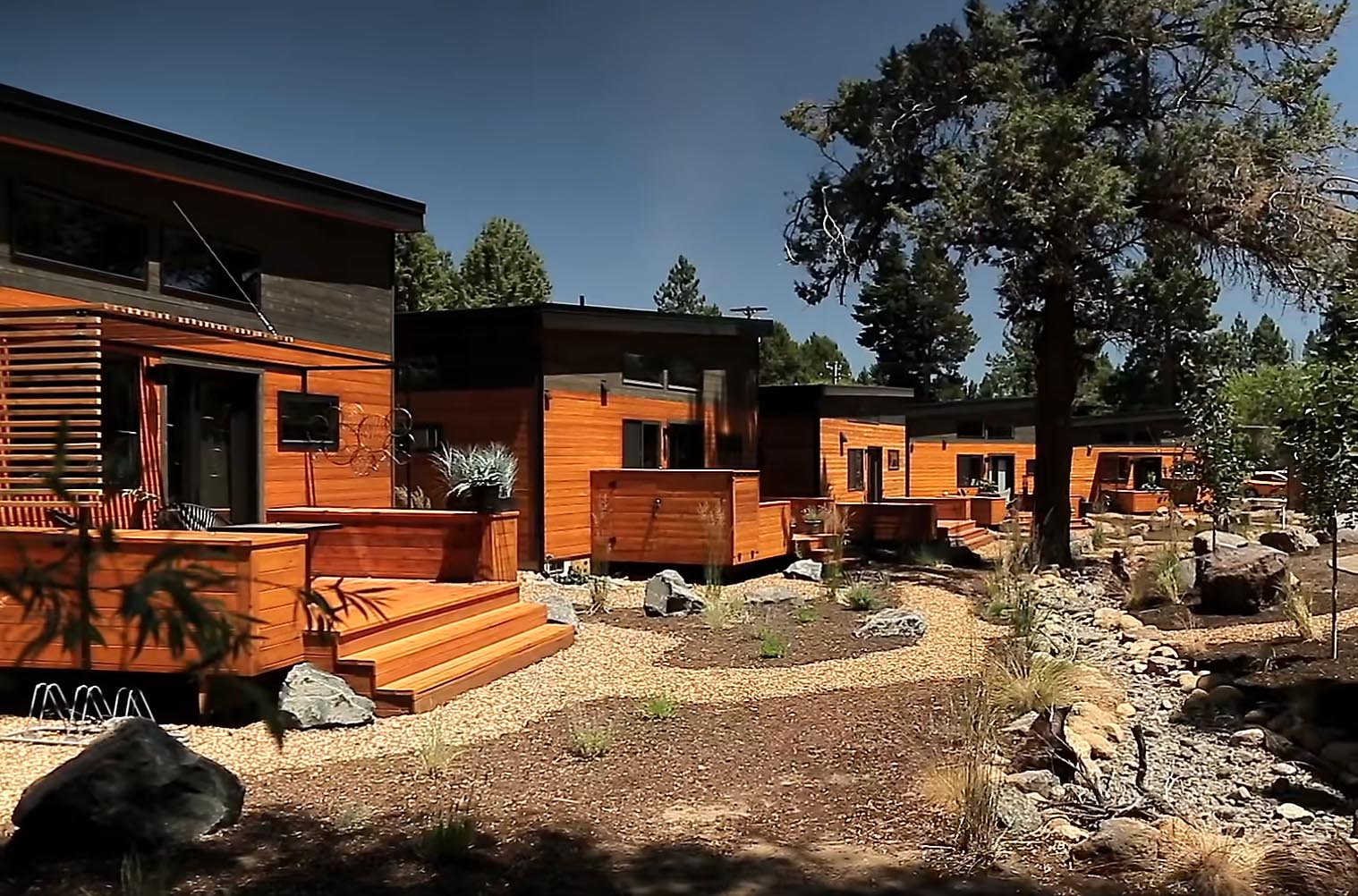
Conclusion
The rise of tiny house communities is more than a trend; it’s a movement towards redefining the very essence of home, community, and environmental stewardship. As we navigate the challenges of the 21st century, the principles of tiny living offer a roadmap for a sustainable, connected, and fulfilling future. This movement challenges us to reconsider our values and priorities, making a compelling case for the beauty and possibility inherent in living small.
